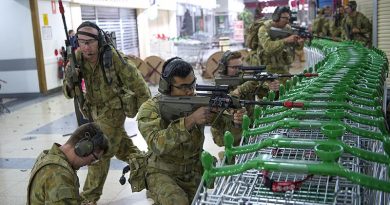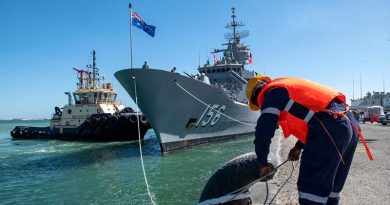Defence Innovation Hub grants April 2020

The government has announced another list of grant recipients from the Defence Innovation Hub, following hotly on a Monday’s announcement titled ‘Sovereign Industrial Capability Priority Grants‘.
FILE PHOTO (November 2019): Private Kai Cooper (centre) from the 2nd Battalion, Royal Australian Regiment, during amphibious raid training at the Cowley Beach Training Area, north Queensland. Photo by Sergeant Jake Sims.
Imagine Intelligent Materials Ltd has been awarded $271,000 to explore the application of advanced materials on military body armour.
Cutting-edge space technologies and radar systems are among eight new projects being developed by Australian industry through the Government’s $640m Defence Innovation Hub.
Minister for Defence Industry Melissa Price said the new Defence Innovation Hub contracts announced today were worth more than $14.6 million.
“The latest tranche of investments includes seven contracts awarded to small businesses from across Australia and a contract with University of Technology Sydney,” Minister Price said.
“These contracts will support the development of a range of technologies that span areas such as space, electronic warfare, and power generation to build a more advanced and capable Defence Force.
“More than $3 million has been awarded to NSW’s Jenkins Engineering Defence Systems to continue the development of its radar electronic support system.
“This technology has the potential to provide the Navy with a cost-effective system to automate warnings and determine the type and location of radar signals.
“South Australian based DEWC Systems has been awarded a $3.1 million contract to develop a sovereign space tactical sensor system.”
The Defence Innovation Hub has awarded over $200 million in innovation contracts, with more than 80 per cent of this investment flowing to small Australian businesses.
Industry and research organisations can submit innovation proposals through the Defence Innovation Portal at: www.innovationhub.defence.gov.au.
Contracts announced today:
| Organisation | State | Contract Value (GST incl) | Description of innovation |
| Jenkins Engineering Defence Systems Pty Ltd (JEDS) | NSW | $3.2 million | To continue the development of its radar electronic support system. If successful, this innovative technology has the potential to provide the Navy with a cost-effective system to automate warnings and determine the type and location of radar signals. |
| DEWC Systems Pty Ltd | SA | $3.1 million | To develop a sovereign, space-based tactical sensor system. If successful, this technology will enhance the ADF’s space capability in the space domain. |
| SYPAQ Systems Pty Ltd | VIC | $2.7 million | To continue the development of a sophisticated, small, lightweight unmanned aerial system that has the potential to enhance situational awareness in complex and rapidly changing environments. |
| SYPAQ Systems Pty Ltd | VIC | $2.2 million | To develop a small, lightweight next generation power generator. If successful, this technology will be suitable for individual soldiers and vehicle‑based forces, enhancing operational capacity through mobile power generation. |
| University of Technology Sydney | NSW | $1.2 million | To develop sensors and decoders which could allow for communication between human brains and robots. This technology has potential applications across multiple industries, including Defence capability, medical and bio-technology as well as education and training sectors. |
| Glia Diagnostics Pty Ltd | VIC | $1.1 million | To develop a medical test and sample collection device, that can be used to diagnose traumatic brain injury and concussion. This innovation could improve the diagnosis, triage and treatment outcomes for Defence personnel who may be impacted by traumatic brain injury. |
| Missions Systems Pty Ltd | NSW | $838,000 | To develop mine neutralisation technology which seeks to enhance the safety of ADF personnel in the maritime domain. |
| Imagine Intelligent Materials Ltd | VIC | $271,000 | To explore the application of advanced materials on military body armour. If successful, this technology could enhance the safety of Australian Defence Force members and reduce maintenance costs. |
.
.
.
.
.
.

.
.





